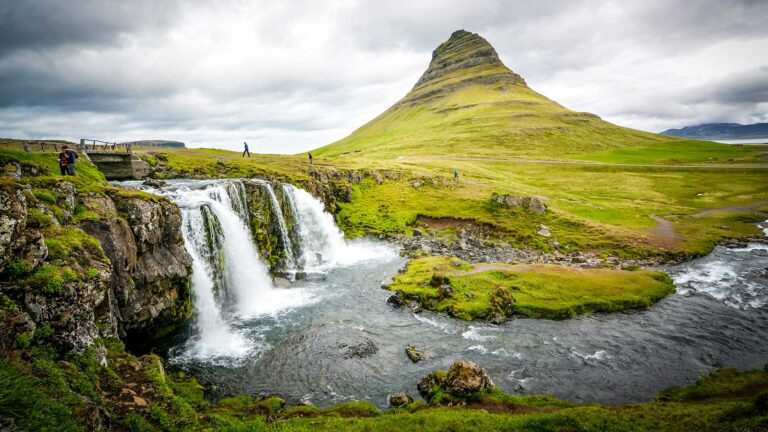While popular National Parks like Yellowstone and Yosemite are undeniably stunning, sometimes the best experiences are found off the beaten path. Exploring the least popular National Parks can be incredibly rewarding, offering solitude, untouched landscapes, and a sense of adventure that you won’t find in more crowded parks.
So pack your bags, and let’s set out to discover America’s hidden gems in the 10 least visited US National Parks.
The Least Popular National Parks in the US
In 2023, the US National Park system registered a whopping 325 million visitors across the 429 national park sites. And it’s no surprise that some of the more popular ones like the Grand Canyon National Park, account for a large portion of that. However, it’s often the least popular national parks that turn out to be America’s hidden gems.
So, using annual visitation data collected by the NPA (National Park Service), we’ve rounded up the top 10 least popular US National Parks in 2023:
1. Gates of the Arctic National Park, Alaska
Recreational Visits: 11,045

With just 11,045 visitors in 2023, Gates of the Arctic National Park is officially the least popular National Park in the US. It’s located in northern Alaska, entirely above the Arctic Circle, and spans over 8.4 million acres making it the second largest US National Park. And with no roads or access trails, it is truly one of the most remote and pristine wilderness areas in the United States. From the meandering rivers that work their way through glacier-carved valleys to the herds of caribou that migrate through the park, the park is home to some of the most breathtaking landscapes on the planet.
Why you should visit: it’s the ultimate wilderness adventure. With no roads or trails into the park, the only access is by plane or on foot. And once you’re there, you’ll have to rely on your own outdoor skills to survive. It’s the ultimate wild camping adventure!
2. American Samoa National Park, American Samoa
Recreational Visits: 12,135

The second least popular US National Park is American Samoa National Park. Located in the US territory of American Samoa, it’s 2,200 miles southwest of Hawaii and is actually closer to Australia than the US, which probably explains why it received just 12,135 visitors in 2023. The park covers an area of 8,256 acres and is spread across four islands: Tutuila, Ofu, Olosega, and Ta‘ū. Above all, it’s known for its biodiversity both in its tropical rainforests on land and in its coral reefs below water.
Why you should visit: because it offers many of the incredible aspects that Hawaii does without the crowds. It’s ideal for hiking and snorkelling enthusiasts looking for an adventure off the beaten track.
3. Lake Clark National Park, Alaska
Recreational Visits: 16,728

Located in southern Alaska about 100 miles southwest of Anchorage, Lake Clark National Park & Preserve spans over 4 million acres, making it one of the larger national parks in the United States. And much like the Gates of the Arctic National Park, it can only be reached by boat or small aircraft as there are no roads into the park.
Lake Clark National Park is renowned for its stunning scenery including snow-covered mountains, icy glaciers, turquoise glacial lakes and even active volcanoes. Not to mention the abundance of wildlife throughout the park, from the bears, moose and wolves that roam the grounds to the sea lions and whales that guard the coastal regions and the eagles that soar through the skies.
Why you should visit: because it’s considered to be one of the best places for bear watching in Alaska. And if that wasn’t enough, the abundance of other terrestrial and marine wildlife, as well as the incredible landscapes are surely worth a visit.
4. Kobuk Valley National Park, Alaska
Recreational Visits: 17,616

Kobuk Valley National Park is a remote and pristine wilderness area located in northwestern Alaska, known for its unique and stunning natural landscapes. Encompassing approximately 1.75 million acres, the park is situated north of the Arctic Circle and offers a glimpse into one of the most unspoiled regions of the United States. From the Great Kobuk Sand Dunes to the thousands of caribou that migrate through the park, Kobuk Valley National Park has something for everyone.
Why you should visit: whether you’re into hiking and backpacking, wildlife watching or kayaking, Kobuk Valley is sure to reward you for venturing into the remote wilderness of the park.
5. Isle Royale National Park, Michigan
Recreational Visits: 28,965

Located in Lake Superior in the northern state of Michigan, Isle Royale National Park is a remote island wilderness that is only accessible by ferry, seaplane, or private boat. With an area of just over 206 sq miles, Isle Royale is actually the fourth-largest lake island in the world and has been a UNESCO International Biosphere Reserve since 1980. Isle Royale National Park is known for its abundant wildlife including wolves, moose, foxes, beavers and more. And with no roads and just 28,965 visitors last year, it’s the perfect location for hiking, kayaking, diving and so much more.
Why you should visit: because it’s a great place to experience nature and wildlife without the noise of the cars or the buzz from the crowds.
6. Katmai National Park, Alaska
Recreational Visits: 33,763

Located in the rugged and remote expanse of southern Alaska on the Alaska Peninsula, Katmai National Park and Preserve encompasses approximately 4.1 million acres of breathtaking wilderness. It’s home to a diverse range of stunning landscapes, dynamic geological features, and abundant wildlife, offering visitors an unparalleled glimpse into the raw beauty of Alaska.
The park’s most iconic geological feature is the Valley of Ten Thousand Smokes, created by the cataclysmic eruption of Novarupta in 1912, the largest volcanic event of the 20th century. But Katmai is probably best known for its diverse array of other wildlife and, in particular, for its impressive population of brown bears. In fact, Katmai National Park has so many brown bears that they host an annual Fat Bear Week, in which the public can vote on the fattest bear.
Why you should visit: ever wanted to watch bears catching salmon as they jump out of the water? Katmai National Park is the place to do it!
7. North Cascades National Park, Washington
Recreational Visits: 40,351

About three hours from Seattle, North Cascades National Park spans over 500,000 acres of pristine alpine wilderness in the northwestern state of Washington. It’s home to some of the most dramatic mountain scenery on the planet including jagged peaks, deep valleys and over 300 glaciers. So it will come as no surprise that it’s almost overflowing with water. From roaring rivers and rushing waterfalls to pristine lakes surrounded by lush, dense forests, the North Cascades offer a similar experience to the PNW (Pacific Northwest), minus the crowds. In fact, it had less than 2% of the visitors that neighbouring National Parks like Olympic National Park and Glacier National Park have.
Why you should visit: with just a fraction of the visitors, you’ll be able to experience the true wilderness of the PNW without the crowds.
8. Wrangell - St. Elias National Park, Alaska
Recreational Visits: 78,305

Covering an area of more than 13 million acres, Wrangell-St. Elias National Park is the largest National Park in the United States. Located in Southeastern Alaska, the park stretches from the sea to some of North America’s highest summits in Mount St. Elias, which stands at 18,008 feet. And in between, you’ll find breathtaking landscapes bursting at the seams with wildlife including grizzly bears, moose, caribou, wolves and more. It’s also home to some of the largest glaciers outside the polar regions, like the Malaspina Glacier which is approximately the same size as the state of Rhode Island.
Why you should visit: a glacier the size of Rhode Island, bears, moose, wolves and caribou. Need we say more?
9. Dry Tortugas National Park, Florida
Recreational Visits: 84,285

A small paradise located about 70 miles west off the coast of Key West in southern Florida, Dry Tortugas National Park is a 100-square mile park that is mostly open water but includes seven small islands. As you’d expect, it’s only accessible by boat or seaplane making it one of the most remote National Parks in the US.
It is known for its crystal-clear waters, abundant marine life and historic Fort Jefferson. And while one of the park’s highlights is the historic Fort Jefferson, it’s the crystal-clear waters teeming with colourful coral reefs and abundant marine life including sea turtles, barracudas, and nurse sharks that make it a paradise for snorkelling and diving. The park is also popular amongst bird watchers too as it hosts over 300 bird species during the migration seasons. And if that wasn’t enough, its remote location close to the equator and with minimal light pollution also makes it an ideal place for stargazing.
Why you should visit: if you like snorkelling, diving or birdwatching, it’s a great place to get up close to marine and bird life without the crowds you’ll encounter in the other parts of the Florida Keys.
10. Great Basin National Park, Nevada
Recreational Visits: 143,265

And finally, with a whopping 143,265 visitors in 2023, Great Basin National Park covers an area of 77,180 acres in eastern Nevada near the Utah border.
From exploring the underground marble cave system of the Lehman Caves or scaling the 13,063 foot Wheeler Peak, to walking amongst bristlecone pines and gazing into the darkest of skies, Great Basin National Park offers something for everyone.
Why you should visit: whether you’re looking for extreme hikes or family friendly adventures, Great Basin National Park offers the chance to enjoy nature away from the crowds.
And that’s it! Those are the 10 least visited National Parks in the United States. Interestingly 5 out of the top 10 are in Alaska, which just goes to show that the only reason these hidden gems receive so few visitors is that they are difficult to get to. But one thing’s for sure: you’ll be rewarded for your effort when you get there!
- Gates of the Arctic National Park – National Park Service, Alaska via Flickr
- American Samoa National Park – Wikimedia Commons
- Lake Clark National Park – National Park Service, Alaska via Flickr
- Kobuk Valley National Park – National Park Service, Alaska via Flickr
- Isle Royale National Park – Ray Dumas via Flickr
- Katmai National Park – Katmai National Park via Flickr
- North Cascades National Park – Wikimedia Commons
- Wrangell – St. Elias National Park – National Park Service, Alaska via Flickr
- Dry Tortugas National Park – Wikimedia Commons
- Great Basin National Park – Frank Kovalchek via Flickr




